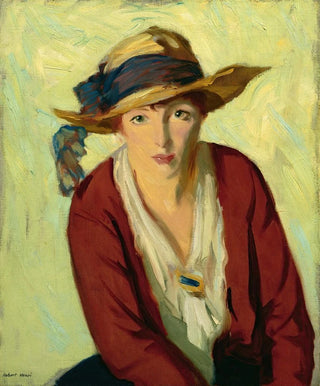Art print | The beach hat - Robert Henri


View from behind

Frame (optional)
"Le chapeau de plage" by Robert Henri is an iconic artwork that transports viewers to a moment of summer leisure. This canvas, painted in the early 20th century, evokes not only the beauty of coastal landscapes but also the joy of living that characterizes summer holidays. Henri, a master of portrait and landscape, manages to capture the essence of a sunny day on the beach, where every brushstroke seems to vibrate with warmth and light. The composition of the piece draws the eye, inviting one to immerse themselves in the gentle atmosphere of the moment. Gazing at this painting, one can almost hear the sound of the waves and feel the sea breeze, making it a must-have piece for anyone who appreciates lively and evocative art.
Style and uniqueness of the work
The uniqueness of "Le chapeau de plage" lies in Robert Henri's distinctive style, which is rooted in the realist movement while incorporating impressionist elements. The color palette chosen by the artist is both vibrant and harmonious, with warm tones that evoke sunlight and water reflections. The human figures, though stylized, are depicted with such expressiveness that they seem to come alive before the viewer's eyes. Henri skillfully plays with light and shadow, creating a contrast that adds depth to his subjects. Every detail, from the straw hat to the shadows cast on the sand, is carefully studied to enhance the atmosphere of relaxation and pleasure. This artwork does not merely depict a beach scene; it tells a story, that of a time when life seemed simpler and more joyful.
The artist and his influence
Robert Henri, a central figure of the Ashcan School movement, left a significant mark on American art through his innovative approach and his desire to portray everyday life authentically. Born in 1865, he was influenced by great European masters while developing a style that was uniquely his own. Henri captured the essence of his contemporaries, highlighting beauty in the mundane. His teaching also had a considerable impact on the next generation of artists, who

Matte finish

View from behind

Frame (optional)
"Le chapeau de plage" by Robert Henri is an iconic artwork that transports viewers to a moment of summer leisure. This canvas, painted in the early 20th century, evokes not only the beauty of coastal landscapes but also the joy of living that characterizes summer holidays. Henri, a master of portrait and landscape, manages to capture the essence of a sunny day on the beach, where every brushstroke seems to vibrate with warmth and light. The composition of the piece draws the eye, inviting one to immerse themselves in the gentle atmosphere of the moment. Gazing at this painting, one can almost hear the sound of the waves and feel the sea breeze, making it a must-have piece for anyone who appreciates lively and evocative art.
Style and uniqueness of the work
The uniqueness of "Le chapeau de plage" lies in Robert Henri's distinctive style, which is rooted in the realist movement while incorporating impressionist elements. The color palette chosen by the artist is both vibrant and harmonious, with warm tones that evoke sunlight and water reflections. The human figures, though stylized, are depicted with such expressiveness that they seem to come alive before the viewer's eyes. Henri skillfully plays with light and shadow, creating a contrast that adds depth to his subjects. Every detail, from the straw hat to the shadows cast on the sand, is carefully studied to enhance the atmosphere of relaxation and pleasure. This artwork does not merely depict a beach scene; it tells a story, that of a time when life seemed simpler and more joyful.
The artist and his influence
Robert Henri, a central figure of the Ashcan School movement, left a significant mark on American art through his innovative approach and his desire to portray everyday life authentically. Born in 1865, he was influenced by great European masters while developing a style that was uniquely his own. Henri captured the essence of his contemporaries, highlighting beauty in the mundane. His teaching also had a considerable impact on the next generation of artists, who






